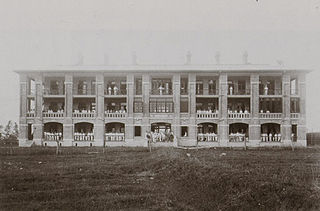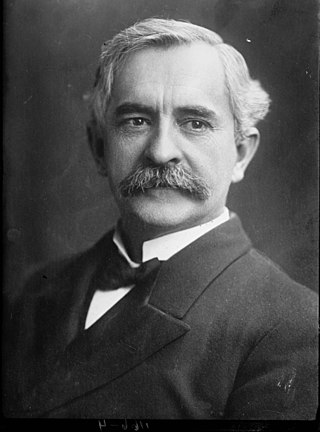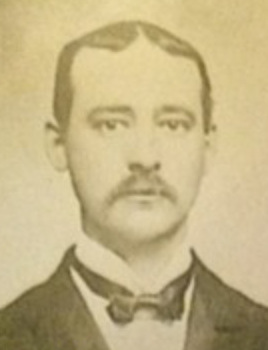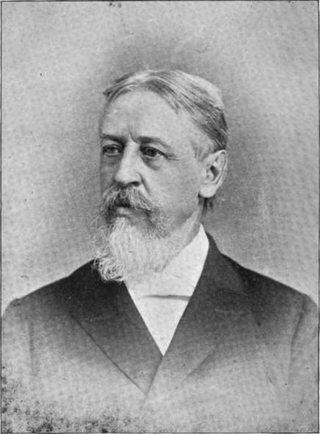
Albert Benjamin Simpson, also known as A. B. Simpson, was a Canadian preacher, theologian, author, and founder of the Christian and Missionary Alliance (C&MA), an evangelical denomination with an emphasis on global evangelism that has been characterized as being Keswickian in theology.

Lingnan University in Guangzhou (Canton), China, was a private university established by a group of American missionaries in 1888. At its founding it was named Canton Christian College (格致書院).

Thomas De Witt Talmage was a preacher, clergyman and divine in the United States who held pastorates in the Reformed Church in America and Presbyterian Church. He was one of the most prominent religious leaders in the United States during the mid- to late-19th century, equaled as a pulpit orator perhaps only by Henry Ward Beecher. He also preached to crowds in England. During the 1860s and 70s, Talmage was a well-known reformer in New York City and was often involved in crusades against vice and crime.

Amzi Clarence Dixon was a Baptist pastor, Bible expositor, and evangelist who was popular during the late 19th and the early 20th centuries. With R.A. Torrey, he edited an influential series of essays, published as The Fundamentals (1910–15), which gave Christian fundamentalism its name.

The New York Avenue Presbyterian Church is a Presbyterian Church in Washington, D.C. The church was formed in 1859–1860 but traces its roots to 1803 as the F Street Associate Reformed Presbyterian Church and another congregation founded in 1820 on its current site, the Second Presbyterian Church. It is located at the intersection of 13th Street and New York Avenue in the city's Northwest quadrant, four blocks from the White House. Due to its proximity to the White House, a number of U.S. presidents have attended services there.

Jennings Ligon Duncan III is an American Presbyterian scholar and pastor.

David Steele, Sr. was a Reformed Presbyterian or Covenanter minister.

The First Baptist Church in the City of New York is a Baptist church based in a sanctuary built in 1890–93 at the intersection of Broadway and West 79th Street in the Upper West Side of Manhattan, New York City. The church is affiliated with the Southern Baptist Convention.

Samuel Miller was a Presbyterian theologian who taught at Princeton Theological Seminary.

Gardiner Spring was an American minister and author. He served as pastor of the Brick Presbyterian Church in New York City for 63 years.

Theodore Ledyard Cuyler was an American Presbyterian minister and writer.

Lyman C. Pettit was the founder and first president of the Pentecostal Collegiate Institute ; the founding pastor of both the Congregational Methodist Church of Saratoga Springs, and the First People's Church of Brooklyn, New York; and an ordained clergyman who was the pastor of churches in the Methodist Episcopal Church, the Association of Pentecostal Churches of America, and the Presbyterian Church in the United States of America.
Septimus Tustin was a Presbyterian clergyman who served as Chaplain of the United States House of Representatives in 1837 and as Chaplain of the United States Senate 1841–1846.

The Second Congregational Church in New York, organized in 1825, was a Unitarian congregation which had three permanent homes in Manhattan, New York City, the second of which became a theater after they left it. In 1919 the congregation joined the Community Church Movement and changed its name to Community Church of New York. The same year its church, on 34th Street, was damaged by fire. Since 1948 the congregation has been located at 40 East 35th Street. It is currently part of the Unitarian Universalist Association.
West Presbyterian Church was a congregation and two houses of worship in Manhattan, New York City. The congregation was founded in 1829 and merged in 1911 with Park Presbyterian Church to form West-Park Presbyterian Church. The first house of worship, also known as the Carmine Street Presbyterian Church, in Greenwich Village, was used from 1832 to 1865, and the second, on West 42nd Street between Fifth Avenue and Sixth Avenue, from 1865 until 1911, when it was sold and demolished. Proceeds from the sale were used, in accordance with the merger agreement, to build and endow a church for an underserved neighborhood, Washington Heights: Fort Washington Presbyterian Church. In addition, the West Church congregation had earlier established two mission churches which eventually merged to become Good Shepherd-Faith Presbyterian Church. West-Park, Fort Washington, and Good Shepherd-Faith are all active today.

The First Presbyterian Church, known as "Old First", is a church located at 48 Fifth Avenue between West 11th and 12th Streets in the Greenwich Village neighborhood of Manhattan, New York City. It was built in 1844–1846, and designed by Joseph C. Wells in the Gothic Revival style. The south transept of the building was added in 1893–1894, and was designed by the firm of McKim, Mead & White. The church complex, which includes a parish house – now referred to as the "South Wing" – on West 11th Street and a church house on West 12th Street designed by Edgar Tafel, is located within the Greenwich Village Historic District.
William Pierson Merrill (1867–1954) was an American Presbyterian clergyman, pacifist, author, and hymn writer. He was acknowledged during his time as one of the most influential ministers in America. He is probably best remembered as the author of several well-known hymns, including "Rise Up, O Men of God".
Marvin Richardson Vincent was a Presbyterian minister, best known for his Word Studies in the New Testament. From 1888, he was professor of New Testament exegesis and criticism at Union Theological Seminary, New York City.

Reverend George Creider Heckman D.D., LL.D was a Presbyterian minister and the ninth president of Hanover College serving from 1870 to 1879.

Reverend James Hall Mason Knox D.D., LL.D was a Presbyterian divine and educator, serving as the 8th president of Lafayette College.
















